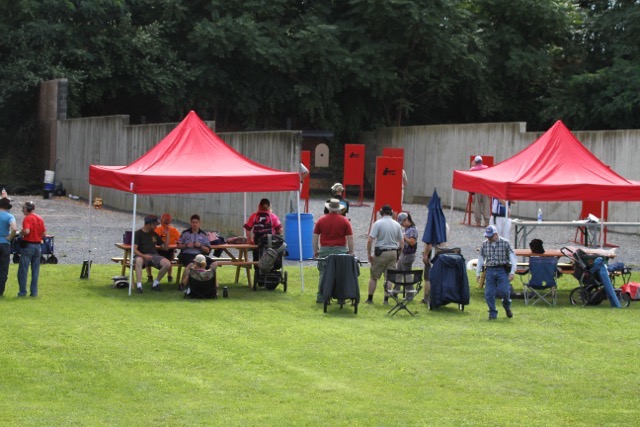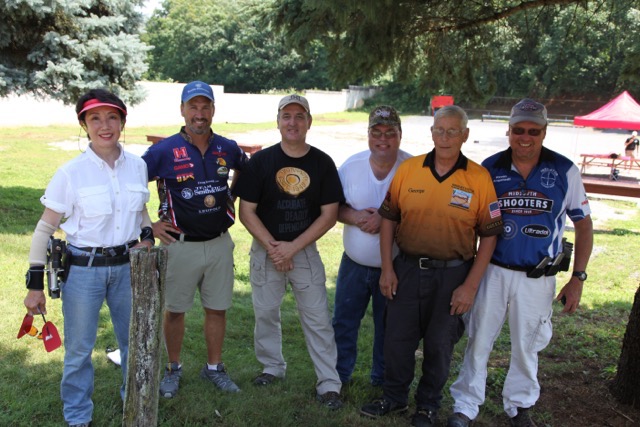Competing at the Bianchi Cup is not for the meek and faint hearted. The national event can be very intimidating because of the high number of participants, plus the spectators. The energy is high-powered. Thriving at Bianchi Cup requires consistent practice. It requires proper preparation. It also requires calm nerves. To hone your skills in those areas, I recommend that shooters compete in state and regional tournaments throughout the year, so they will feel at ease when they compete on the big stage at the Bianchi Cup.
Sponsored by Vera Koo
In my 19 years competing at the Bianchi Cup, I have watched as the number of female participants has grown from 8 to as many as 41. Participation also has grown greatly among male shooters. One-third of the shooters at Bianchi this year were new shooters. Unfortunately, participation in state and regional matches hasn’t escalated quite the same way.
Each year, I will see rookie shooters compete at Bianchi, but then I do not see many of these rookie shooters at the regional tournaments at which I participate.
Shooting in regional matches should be viewed as part of the job description if you want to excel at Bianchi Cup. Regionals are like a testing ground. By participating at these smaller-scale events, you can condition yourself for the national match. Five years ago, I competed in 16 events in one year, and I still compete in multiple events throughout each year.

Beautiful red canopies and picnic tables everywhere at the Regional Championship at the Chambersburg Pistol and Rifle Club. (Vera Koo photo)
The regional match at the Chambersburg Pistol and Rifle Club in Chambersburg, Pa., is one of my favorite regional competitions, and I have competed there the past 6 years.
“You don’t get near the prize or the grandeur or the exposure as you do at Bianchi, but it’s definitely a training ground,” said George Martin, the match director and club vice president at Chambersburg.
This year, the regional took place on July 18. It was followed the next day by a state match, the Keystone Cup.
The regional attracts primarily shooters from the Northeast. Competitors from Delaware, Maryland, Virginia, West Virginia, New Jersey and New York have joined the in-state competitors over the years. However, the regional also has attracted shooters from California, Louisiana, Ohio, South Carolina and Canada.
The setting at the Chambersburg Pistol and Rifle Club is ideal. The range is set 100 yards off a road in a residential area. The driveway leading up to the range is lined by pine trees and gives you a heart-warming feeling, almost emitting a Christmas vibe. The grounds are made for comfort for the shooters, with canopy-covered picnic tables scattered around.
This year, Deborah Travis of Packing in Pink, Annette Evans of Sig, Kirsten Hill and I were the 4 female competitors at the regional.
“In the beginning we had no women,” Martin said. “We had 4 this year. That’s not bad, because the other regionals that were close, I don’t think they get 4. Four is good.”
Eight would be better.
This year’s regional also featured top pro men’s shooters, including Doug Koenig, Carl Bernosky and Kevin Angstadt.
“If I were a golfer, I would never get to be able to play with Tiger Woods or somebody else like him,” Martin said. “You can rub elbows with the world’s best at these regionals.”
While rubbing elbows with those top shooters, you can pick their brains, too. These regional events are much more laid back than the Bianchi Cup. Elite shooters are very welcoming toward unseasoned shooters who are looking to learn.

Vera Koo with friends and fellow shooters Doug Koenig, Carl Bernosky, Kenny Johnson, George Martin and Kevin Angstadt
Regional events provide an opportunity to find a mentor who can help accelerate your skills and put you on the fast track to succeeding at the Bianchi Cup. Take advantage of the chance to get their advice on equipment or a specific event and gather tips for your stance, grip and strategy. Not all of the advice you receive will work for you, but you can test out the advice you receive and keep what works and discard what does not.
Regional matches offer a setting in which you can approach master shooters and try to latch on as an understudy. If you are coached by a top shooter, progress will come so much faster for you, and you will not find yourself making the kind of mistakes that other novices will.
Also, participating in regionals will help you learn how to properly prepare for various conditions. The more matches you shoot in, the more types of weather you will experience. As such, you will know how your body reacts in various weather and what type of clothing you need to wear to best perform in those situations. You will learn what equipment works best for you. You will figure out a match-day routine that suits you. You will learn the timing of events and get to the point to where your actions become second-nature reflex.
One of the best aspects of the regional at Chambersburg is it follows the same 4-stage format that you will see at Bianchi by featuring the Practical, Barricade, Mover and Plates events. This is important, because, as Martin noted, “There are not that many places that offer Bianchi-style shooting.” Like Bianchi, your scores in those 4 events are tallied for your aggregate score.
“It gives you experience you can take into the Bianchi Cup,” Martin said. “Plus, at registered regional matches, you can set records and you can also get points to get your Distinguished Badge. That’s a big thing now. We’ve got a lot of good shooters. Most everybody that does this for a year or two wants to get distinguished, and you earn so many points based on how high up that you finish.”
When I started competing in Bianchi Cup, I had little idea what I was doing. I wish I would have known about state and regional matches at that time and honed my skills there.
Every match you experience helps prepare you for nationals. After you have put in the work and practice by going to as many matches as you can, you will be rewarded with better results at the Bianchi Cup.
Vera Koo is a first-generation Chinese American woman. She’s a wife and mother, author, entrepreneur and retired competition shooter. Along with two published books -- "The Most Unlikely Champion" and "Wisdom and Things: Essays From an Unlikely Champion" -- she writes her column, Vera Koo, at "Women’s Outdoor News." View all posts by Vera Koo